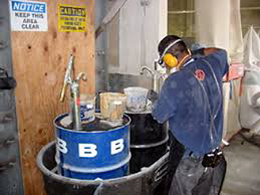Safety & Industrial Hygiene
Here below, polyurethane components are investigated from safety & hygiene point of view. It should be remembered that completely reacted polyurethane polymers have no any hazardous potential. Only the irritation potential may come by its fine dusts. But it is not different from any other inert dusts in our environment.Polyols
In case they are used in accordance with regulations, polyols have no considerable harmfull effect to human body. However, mentioning about polyol formulations one should also consider amin catalysts and other additives which may have allergic potential. In addition to that, one may have insignificant sysmptoms such as headache, nausea or skin irritation who is exposed to direct contact of polyol formulation. Considering some amin catalysts can penetrate into skin and interfere into systemic circulation, it should be avoid from direct contact of polyol formulations. On the other hand, polyol recipes do not contain more than a few percent of such additives generally. Using eye glasses and gloves is simple but an important protection not only for polyols but also for all other chemicals.

In case a direct contact to skin or eye due to exposure to polyol takes place, the first precaution should be removing it by washing the area with plenty of water. Seldomly, polyol type could be insoluble in water. In that case after removing the chemical with water area could be treated with one other substance like PEG (polyethyleneglycol)-400. In anycase, it should be fundamental procedure for any processor.
» Taking simple and basic precautions such as eye glasses and gloves.
» Investigating “Safety Data Sheets” of the products that are in use.
» In case of an exposure, having some first aid measurements such as removing chemicals mechanically, washing the location with excess water.
» Applying to a medical doctor immediately.
Isocyanates
Since isocyanates have reactive NCO groups. They can react to amin (NH2) and OH groups. It means in case of a direct contact (to skin or eye), NCO group will react with water there. It may cause drying and irritation on the media. So the best first aid would be again splushing the area with plenty of water.
In addition, it may cause irritation on respiratory system in case isocyanate vapours are inhaled over certain limits for a long periods. Although its irritation potential changes from type to type, generally Threshold Limit Value (TLV) for isocyanates is accepted as 0.01 ppm (mg/m3) in a working environment. Above mentioned fundemental precautions are valid also for isocyanates.

E-Newsletter


